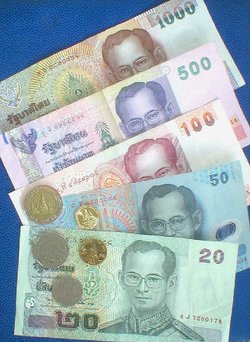Baht
|
|
The baht (บาท, symbol ฿, ISO 4217 code THB) is the official currency of Thailand. The issuance of currency is the responsibility of the Bank of Thailand. It is divided into 100 satang. As of January 1, 2005, there were 52.6667 Baht to the Euro, 38.9099 to the US dollar, and 74.6860 to the British pound. The value tends to hover around 40 to the US dollar.
Coins in circulation ([1] (http://www.trd.mof.go.th/template.php?selectedMenuIdx=5&targetURL=/currency/circulation_text.htm) - in Thai). The introduction of a 2 Baht coin is currently in discussion.
- 25 satang (brass)
- 50 satang (brass)
- 1 Baht (cupronickel)
- 5 Baht (cupronickel with copper rim)
- 10 Baht (bimetallic; brass center, cupronickel exterior
Banknotes in circulation [2] (http://www.bot.or.th/bothomepage/BankAtWork/Banknotes/Issue/Issue_1/Data/current_series_e.htm)
- 10 Baht - Orange (becoming rare)
- 20 Baht - Green
- 50 Baht - Blue (Polymer version being phased out)
- 100 Baht - Red (New bills as of 2005 have silver security strip)
- 500 Baht - Purple (With security strip)
- 1000 Baht - Grey/Brown (With security strip)
Many commemorative 10 baht coins have been made for special events. Even though the satang-denominated coins are legal tender, small shops usually don't accept them anymore. Older coins which are still in circulation only had the Thai numerals, but the new design also has arabic numerals. All coins have a portrait of King Bhumibol Adulyadej on one side. The king is also depicted on each of the banknotes. According to Thai Law, it is illegal for someone to step onto a Thai banknote, as their king's face is on it.
Baht is also a unit of gold measure and is used commonly in jewellers and goldsmith in Thailand, 1 baht = 15.244 grams. (15.244 gram is used for "raw" gold or bullions, in case of jewelery, one baht should be more than 15.16 grams)
| Contents |
History
The present decimal system, in which one baht = 100 satang (สตางค์), was introduced in 1897 by king Chulalongkorn. However until the 1940s it was named tical, then renamed to baht. Originally the term baht was a weight unit of about 15g, and was adopted because one tical was equivalent to 15g of silver.
Until November 27, 1902 the tical was fixed on a purely silver basis, but as the value of silver fell relative to gold-fixed currencies, the fixing was changed. From the lowest rate of 21.75 tical per Pound Sterling it could be raised to 17 tical per pound. In the same year, on September 19, the first banknotes were issued, with denomination of five, ten, twenty, one hundred and one thousand tical. Coins in 1902 were
- Silver coins
- Tical, 15.244 g
- Salung (1/4 tical), 3.8 g
- Fuang (1/8 tical), 1.9 g
- Copper coins
- Song Phai (1/16 tical), 18.9 g
- Phai (1/32 tical), 11.3 g
- Att (1/64 tical), 5.6 g
- Solot (1/128 tical), 2.8 g
One leftovers from the pre-decimalization system, the 25 satang (1/4 baht) is still colloquially called 'salueng' or 'salung' (สลึง). It is occasionally used for not exceeding 10 salueng or 2.50 baht. A 25-satang coin is also sometimes called salueng coin (เหรียญสลึง, pronounced 'lian salueng').
Exchange rates
Since World War II until 1980 the Baht was fixed to the US Dollar at an exchange rate of 1$ = 20 baht. It then slowly decreased in value, and was again pegged to an exchange rate of 25:1 from 1985 until July 2, 1997, but then due to the Asian financial crisis, the Baht was floated which halved its value, to its lowest rate of 56:1 in January 1998. It stabilized again at a rate of about 40:1, which it kept since then.
References
- Cecil Carter eds., The Kingdom of Siam 1904, reprint by The Siam Society 1988, ISBN 9748298132 - Chapter X Currency and Banking
External links
- Current Series of Banknotes in Circulation (http://www.bot.or.th/bothomepage/BankAtWork/Banknotes/Issue/Issue_1/Data/current_series_e.htm)
- Current Series of Coins in Circulation (http://www.trd.mof.go.th/template.php?selectedMenuIdx=5&targetURL=/currency/circulation_text.htm) (in Thai)
- The Royal Thai Mint (http://www.trd.mof.go.th/indexeng/eng/coins.html)
Template:AsianCurrenciesde:Baht fr:Baht id:Baht nl:Baht ja:バーツ pl:Bat sv:Baht th:บาท (สกุลเงิน)

